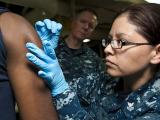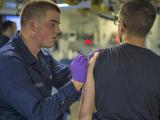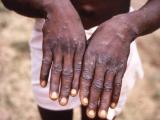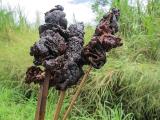Feb 12, 2004 (CIDRAP News) A recent case of vaccinia virus transmission from a soldier to his wife and then to their breast-feeding baby suggests a need for greater precautions by smallpox vaccine recipients and breast-feeding mothers who live together, according to a case report published this week.
The case, reported in the Feb 11 Journal of the American Medical Association, is the first documented instance of vaccinia transmission from a mother to her baby while breast-feeding, according to the three US Army physicians who wrote the article.
Vinaya Garde, MD, and her two coauthors suggest that vaccine recipients should not share a bed with breast-feeding mothers and should do their own laundry, and also that breast-feeding mothers in such households should wash their hands before breast-feeding. Current federal guidelines say that smallpox shot recipients who live with a breast-feeding mother should follow standard hand hygiene and site-protection precautions.
The report says that a 27-year-old soldier was vaccinated May 4, 2003, and had a normal skin reaction, with no drainage from the dressing and little itching. He reported following standard precautions to prevent the spread of vaccinia, but his wife did all the laundry. In mid-May the wife experienced vesicular skin lesions on the areolas of both breasts, but she didn't recognize them as possible vaccinia and continued to breast-feed.
A few days later she saw a physician and was treated for mastitis, which didn't help, the report says. She stopped breast-feeding May 29 because of pain. The same day, a papule developed on her five-month-old baby's philtrum (groove above upper lip), and a similar lesion appeared on the baby's left cheek. A pediatrician examined the infant Jun 2 and noted an ulcer on her tongue in addition to the other lesions.
Lab tests of samples from both mother and baby were positive for vaccinia. To keep the baby's lesions from spreading further, she was isolated and put in soft restraints when not in her mother 's arms, and the lesions were covered with film dressings, the report says. Because the sore on the baby's philtrum continued to weep after 7 days, it was aired under heat lamps 2 to 3 hours a day. The lesions had all crusted over by 13 days after onset, and the baby was released from the hospital after a 12-day stay.
The mother's lesions healed slowly, which was attributed to excessive moisture. She was advised to dry the sores with a blow-dryer three times a day. The lesions were entirely healed by the time of follow-up on Jul 7.
Because of the timing of the lesions, the authors concluded that the virus spread from the vaccinee to his wife and then from her to the infant. They said it was unclear how the virus passed from the soldier to his wife but speculate that she might not have washed her hands between doing laundry and breast-feeding.
Current CDC guidelines caution against smallpox vaccination for breast-feeding mothers and advise vaccinees in the same household to wash their hands after direct contact with the vaccination site or anything that has touched it, according to the report. But in view of this case, the authors state, "We recommend that the CDC revise its guidelines to state that vaccine recipients should not sleep in the same bed as a breastfeeding mother, that vaccine recipients handle their own laundry, and that breastfeeding mothers in these households be reminded to wash their hands prior to breastfeeding."
The authors also note that they considered treating the baby with vaccinia immune globulin (VIG) or cidofovir, but she didn't meet any of the CDC criteria for treatment of a vaccinia complication. Further, none of the available therapies for such complications are licensed for use in children, which underscores the importance of prevention, they observe.
Garde V, Harper D, Fairchok MP. Tertiary contact vaccinia in a breastfeeding infant. JAMA 2004 Feb 11;291(6):725-7 [ Abstract]



















